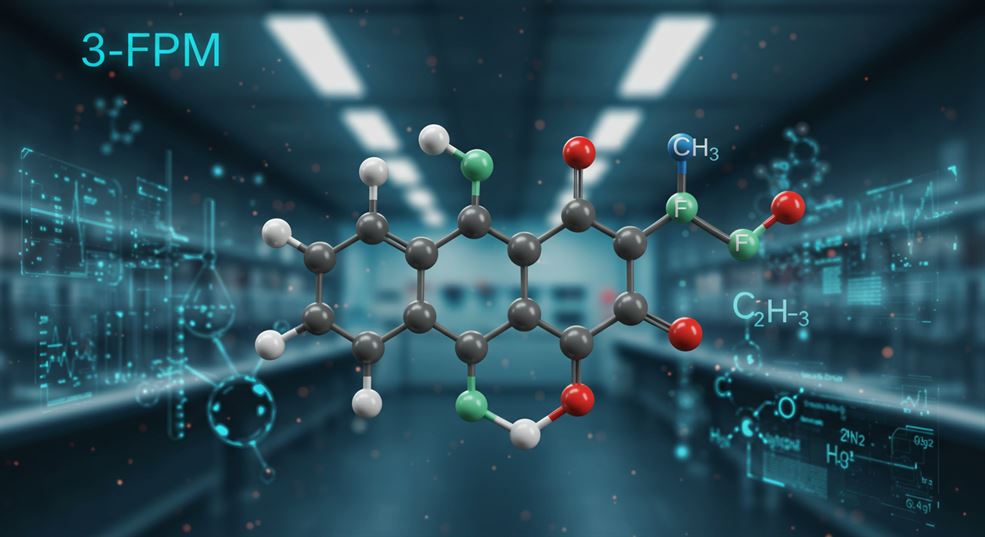Chemical Properties of 3 fpm
The Science Behind Chemical Properties of 3-FPM: Breaking Down Its Chemistry and Effects
3-Fluorophenmetrazine (3-FPM) is a synthetic stimulant that has drawn attention from both researchers and the public. Known for its similarities to phenmetrazine, this compound’s chemical properties set the stage for its psychoactive effects and potential risks. Discover the chemical properties of 3-FPM, its structure, effects, and potential risks. Get the facts before you make any assumptions!
Chemical Structure of 3-FPM
At its core, 3-FPM is a fluorinated derivative of phenmetrazine, a stimulant first synthesized in the 1950s. The addition of a fluorine atom at the 3-position of the phenyl ring alters its interaction with neurotransmitter systems, distinguishing it from its parent compound. Its IUPAC name is 2-(3-fluorophenyl)-3-methylmorpholine, and it appears as a white crystalline powder. With a molecular formula of C₁₁H₁₄FNO and a molecular weight of approximately 195.23 g/mol, this compound’s structure lends itself to both its pharmacological profile and its ease of synthesis. According to the PubChem database, this structural tweak enhances its selectivity for dopamine and norepinephrine reuptake inhibition, a feature shared with drugs like methylphenidate but with distinct pharmacokinetic properties.
This modification also impacts its metabolic stability. Fluorine’s electronegativity slows enzymatic degradation, potentially extending its half-life compared to non-fluorinated analogs. A 2018 study published in the Journal of Psychopharmacology noted that fluorinated stimulants like 3-FPM exhibit prolonged activity in animal models, though human data remains sparse.
For a visual representation of its molecular structure and more detailed chemical information, you can review the ChemSpider entry on 3-FPM. This resource provides an in-depth look at its atom connectivity and offers insights into its stereochemistry, which is important given the presence of chiral centres that may influence its biological activity.
Key Properties Table
| Property | Value |
|---|---|
| Molecular Formula | C₁₁H₁₄FNO |
| Molecular Weight | 195.23 g/mol |
| Physical Appearance | White crystalline powder |
| Boiling Point | Approximately 280.6 °C ± 35.0 °C |
| IUPAC Name | 2-(3-fluorophenyl)-3-methylmorpholine |
Source: Detailed chemical data can be verified on the Cayman Chemical website.
Synthesis and Legality: A Global Patchwork
The synthesis of 3-FPM involves substituting a fluorine atom into the phenmetrazine backbone, a process requiring precise control to avoid unwanted byproducts. While clandestine labs have capitalized on its demand, reputable suppliers like Chem14 emphasize adherence to safety protocols to minimize impurities.
Legally, 3-FPM exists in a gray zone. It’s unscheduled under U.S. federal law but banned in countries like the UK under the Psychoactive Substances Act. The European Monitoring Centre for Drugs and Drug Addiction classifies it as a “novel psychoactive substance,” flagging its potential for misuse despite limited toxicity data.

Pharmacology: How Does 3-FPM Work?
3-FPM primarily targets dopamine and norepinephrine transporters, inhibiting reuptake and amplifying synaptic concentrations of these neurotransmitters. Unlike amphetamines, it doesn’t induce significant serotonin release, which may explain its lower incidence of euphoria—a trait highlighted in user reports aggregated by PsychonautWiki.
Animal studies, such as those cited by the National Institute on Drug Abuse, suggest its stimulant effects are dose-dependent: low doses enhance focus, while higher amounts risk overstimulation. However, human research is virtually nonexistent, leaving gaps in our understanding of its long-term impact.
Researchers have noted that 3-FPM shows a higher selectivity for dopamine and norepinephrine release compared to serotonin. Such selectivity explains why the compound may produce pronounced stimulant effects without the extensive mood modulation often associated with other substances. For additional details on its pharmacological action, consult the Wikipedia page on 3-Fluorophenmetrazine, which offers an accessible summary of its biological activity.
Safety Profile: Known Risks and Unknowns
Anecdotal accounts describe side effects like insomnia, tachycardia, and anxiety, mirroring those of traditional stimulants. Crucially, 3-FPM’s fluorinated structure may pose unique risks. Fluorine metabolites can accumulate in tissues, as noted in a 2020 review by the Journal of Analytical Toxicology, though direct evidence linking this to toxicity in humans is lacking.
| Property | 3-FPM | Amphetamine |
|---|---|---|
| Half-Life | ~6–8 hours | ~10–12 hours |
| Receptor Affinity | Dopamine > Norepinephrine | Dopamine = Norepinephrine |
| Legal Status | Varies by region | Controlled globally |
Ethical and Practical Considerations
The rise of 3-FPM underscores broader debates about unregulated research chemicals. Platforms like Erowid stress harm reduction, advising users to prioritize verified sources and avoid self-experimentation. Meanwhile, policymakers struggle to balance scientific inquiry with public health—a tension evident in the FDA’s stance on synthetic compounds.
Metabolism, Identification, and Analysis
The metabolism of 3-FPM involves a series of biochemical transformations that include N-oxidation and aryl hydroxylation. These metabolic pathways are primarily handled by liver enzymes, such as CYP3A4 and CYP2D6. The resulting metabolites are often detectable in biological samples using advanced techniques like gas chromatography-mass spectrometry (GC-MS) and liquid chromatography-mass spectrometry (LC-MS). Such analytical methods are vital in forensic toxicology to differentiate 3-FPM from its positional isomers.
The identification of 3-FPM in complex samples can be challenging, but analytical laboratories rely on its unique chemical signature. Modern methods such as thin-layer chromatography (TLC) and X-ray crystallography have been used to confirm its structure and purity. For a detailed analysis protocol, refer to the Expert Committee on Drug Dependence repository, which provides a comprehensive report on the substance.
Analytical Techniques and Research Applications
Accurate identification of 3-FPM is essential for both clinical and research applications. Researchers have developed robust methods to detect and quantify the compound even in trace amounts. Electrochemical techniques, for example, have been used to study its oxidation behavior in different buffer solutions, offering insights into its stability and degradation patterns. Such studies not only help in forensic investigations but also in understanding the compound’s behavior under various environmental conditions.
These analytical approaches underscore the importance of using state-of-the-art technology to monitor substances like 3-FPM. Detailed protocols and data can be found in journals like Wiley’s Chemistry Europe, which highlight recent advancements in voltammetric studies of novel psychoactive substances.

Legal Considerations and Market Trends
While 3-FPM has garnered interest for its stimulant properties, it has also been flagged for potential abuse. In several regions, authorities have taken steps to control its distribution. Although it remains unscheduled at the federal level in some countries, specific jurisdictions have imposed restrictions on its use and distribution due to concerns over public health.
Understanding the legal status of 3-FPM is crucial for researchers and consumers alike. It is important to note that the legal landscape can change rapidly as new data emerges about its potential for harm. To stay informed on this front, the Expert Committee on Drug Dependence provides updated assessments and recommendations based on the latest research.
Is 3-FPM legal in the U.S.?
While not federally scheduled, some states regulate it under analog acts. Always check local laws via resources like the DEA Diversion Control Division.
Can 3-FPM cause addiction?
Its dopaminergic action suggests abuse potential, though less than amphetamines. The NIDA recommends caution given the lack of long-term studies.
Does 3-FPM show up on drug tests?
Standard panels don’t screen for it, but specialized tests can detect its metabolites.
Are there medical uses for 3-FPM?
No approved applications exist. Research remains preclinical.
How does 3-FPM compare to caffeine?
It’s far more potent, targeting dopamine directly rather than adenosine receptors.
What makes 3-FPM chemically unique compared to other stimulants?
3-FPM’s distinct chemical structure, which includes a fluorine atom attached to the phenyl ring, sets it apart from other stimulants. This modification influences its interaction with monoamine transporters, making it a potent releaser of dopamine and norepinephrine. For more information, visit the Wikipedia page on 3-Fluorophenmetrazine.
How is 3-FPM detected in forensic labs?
Forensic laboratories use advanced techniques such as GC-MS, LC-MS, and TLC to detect and quantify 3-FPM in biological samples. These methods help differentiate it from similar compounds. Detailed analytical methods are discussed on the Expert Committee on Drug Dependence repository.
What are the primary metabolic pathways of 3-FPM?
The metabolism of 3-FPM primarily involves N-oxidation and aryl hydroxylation, processes that are mediated by liver enzymes like CYP3A4 and CYP2D6. This information is crucial for understanding both its pharmacokinetics and its detection in toxicological analyses.
Is 3-FPM used for any therapeutic purposes?
Currently, 3-FPM does not have any recognized therapeutic use and is mainly available for research and industrial purposes. Its structural similarity to phenmetrazine has raised concerns regarding its potential for abuse, leading to increased regulatory scrutiny.
How can I stay updated on research developments related to 3-FPM?
To keep abreast of the latest research on 3-FPM and other novel psychoactive substances, consider following updates from authoritative sources like the Expert Committee on Drug Dependence and scientific journals available on platforms such as Wiley’s Chemistry Europe,
Cayman Chemical website and ChemSpider.
Final Thoughts: Chemical Properties of 3-FPM: Shocking Facts Revealed!
3-FPM exemplifies the double-edged sword of chemical innovation: promising for research, perilous without oversight. Whether you’re a scientist or a curious reader, staying informed through credible sources like PubMed or Chem14 is non-negotiable.
Have questions or experiences to share? Join the conversation below—we value transparency and informed dialogue.

